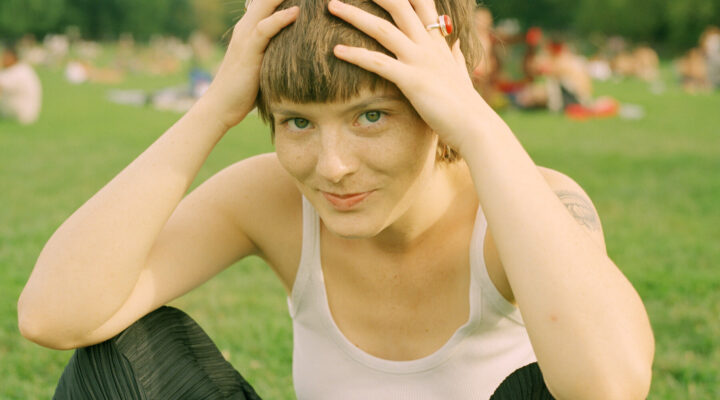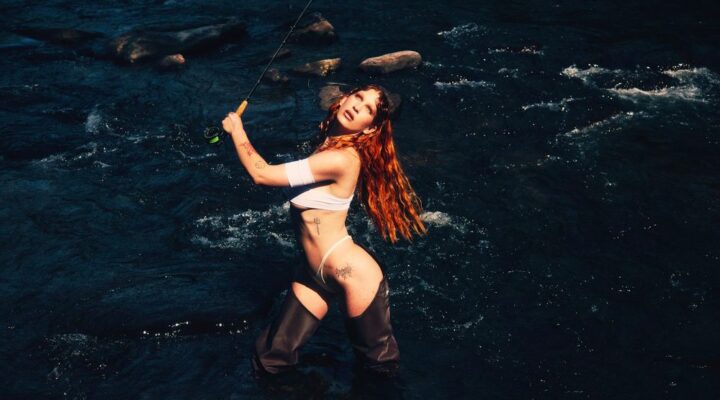An Interview with Grand River
Words by Callum McLean
Photos by Kasia Kim-Zacharko
There are sound designers and composers, technicians and dreamers, thinkers and feelers. And then there’s Grand River. Dutch-Italian, but based in Berlin, Aimée Portioli has become known for sound design and installation work that is as technical and emotionally direct as her musical releases. Her latest installation piece, Tuning the Wind, is a prime example. It’s almost as stirring and accessible as her forthcoming third album, All Above. And that’s despite the conceptual and technical ambition of its brief: to capture and conduct the wind. On the 32-minute piece, altered field recordings of gusts, howls and whistles blend into gradually unfurling synthesisers and strings, as well as a terse, eerie poem. Altogether, it taps into something primordial and fundamental about the elements, but with no hint of loftiness: above all it hits the heart, punching through with more emotional clarity than many pop songs manage.
As Grand River prepares to present the piece in 4D spatial sound at the Concertgebouw, part of Aural Spaces – by Concertvrienden, in collaboration with 4DSOUND and FIBER – we call to talk over how she got here. On screen, Portioli is surrounded by a dense, meticulously organised cockpit of synths, strings, gadgets and gizmos. She speaks deliberately and generously, without jargon or irony – her words flowing fast and clear like, well, a river. We touch on how music communicates, how she learned to hear the wind, and why it seems she can’t help making all of her work – album or installation – so richly melodic and so gut-wrenchingly expressive.
When did you start to become more interested in electronic music?
I’ve always been playing instruments, since I was six, but when I was 14 or 15 I learned to use Cubase so I could record my compositions. That’s when I saw, “Hey, you can cut audio, edit, put things in reverse, add effects!” I discovered you can manipulate audio, basically. Then I bought a drum machine, and that’s what got me to where I am now. I never went to sound design school or anything like that: I was self-taught.
But you did study communication, right?
I studied communication and translation, and there was a course with the psychology department that I loved. They gave me the space to write a thesis about the communicative function of music: I had always been very interested in music and how it can change your perception. That project was really enlightening – and an important step for me in thinking about how music works.
What did you find? How do you understand music to communicate?
Music is a language without words – at least mine is, as there are almost no lyrics involved. For me, it externalises the emotions that I’m feeling. If I have to compose, for a record or an installation or whatever, I translate what I’m feeling. That’s an internal expression that I put into sound: arrangements, timbres, melodies, instead of words.
Is this kind of very expressive, emotional approach something that also carries over to your sound design work?
I’ve been thinking about this a lot recently because the last time I performed Tuning the Wind in 4D, I also went as a fan to listen to the pieces from other artists. I really liked them, but they were so far away from how I would do it. For me, when it’s strictly sound design, it’s harder to find a connection: it’s heavier. Instead, I always include more melodic parts, harmonies. So the two worlds are very close together for me.
Tuning the Wind is definitely much more emotionally direct and accessible than a lot of sound design and installation work, which can be quite serious. Is that something you consciously avoid?
I’m not pulling away from that on purpose, but when you’re composing you get into a kind of state, and when I get deep into a piece I can’t help starting to include harmony or melody. That’s when I feel driven. You have to start building a piece from the bottom, from something that stands out and you want to record. For me, that has to be something that I really feel – a melody, or maybe a resonance – rather than something more intellectual, or colder. I could do that of course, by introducing limits, but then I would feel distant from myself, and I don’t want that. I need to feel that connection.
This is what surprised me so much about Tuning the Wind. I expected something very cerebral or a quite straightforward field recording. But typical wind sounds are almost never clearly audible. Instead, your piece is much richer, more emotional. Why wind then? What was your way in?
My idea was always to integrate the wind as if it was a musical instrument: a voice, a synthesiser, a trumpet, whichever instrument you like. It was more like composing with an orchestra, where the wind was just one piece. I wanted to take a natural element, not something human-made, and bring it into a human-made world. Sometimes the wind whistles and it almost sounds like a flute – that’s exactly what I wanted, to confuse it with something else. The project started on paper, with a concept, and I started to collect wind recordings – by myself and other artists.
How did you go about recording the wind?
I always like to record when I’m on holiday, on my travels. I did some in Greece and Italy. But I don’t consider myself a field recording artist, so I decided to ask other artists who do foley work and see what wind recordings they had. In the end, I just kept the ones from Pablo Diserens. From there, I started listening very closely: analysing what each sound was communicating and how I could transform it.
I had this image in my head of you out in the wilderness with your microphone, struggling up mountains to capture the perfect wind sound! But it sounds like it wasn’t so important to you where those sounds were from – or what they represented – and that you were rather interested in what they could tell you.
Yes, exactly – I don’t even know where most of these recordings are from. It was not about where, but about how they sounded, about what their intention was. I much preferred the manipulation of these sounds than the recording itself. I wanted to see what kind of new life they could have, and how they could become instruments.
Listening to them over and over, I imagine your relationship to those sounds must change, deepen, become more personal as you get closer to them. Did you find that they started to speak to you or mean something different to you over time?
I started from the beginning to really subdivide them into folders: gusts, steady wind, soft wind, whistling wind, etc. Based on the strength of the wind, I was able to think about what I could do with them: like, I could combine a steady wind with a drone. With a gust, which blasts in one movement, I could play it in sync with the notes on this very dynamic synthesiser part, giving more strength to the melody, becoming one chord. Whereas wind of certain strengths would give me different feelings: something calmer from a steady wind than those heavy gusts or sharp whistling – those sound more aggressive.
What impression did you have of the wind itself in the end?
The whole journey of making the piece changed how I feel about the wind for sure. Personally, I have a very love-hate relationship with wind. When I’m somewhere windy, I feel very agitated or restless. But I chose wind as my natural element here because I found it very musical, very flexible or combinable. The wind really happens, it’s created, when it hits something else – because in the end it doesn’t really have its own sound. So it has so many timbres, and that’s an easy place to start from: so many personalities, characters, intentions. I feel like I started to understand it a bit more.
It’s hard to think about a piece like this, based on natural sounds, without remembering the dark side: climate catastrophe, environmental crisis. Are those things you are conscious of on projects like this, or do you want to create a kind of haven, a world of natural sound that’s free from those pressures?
It’s almost impossible not to think about that. We’re surrounded by how the natural world is changing and how it’s influencing us. I started to have this idea about wanting to integrate natural elements into musical composition because I would love to make people more aware of these natural sounds. We take for granted what we have around us: we might see birds outside our window every day, but we don’t know what they’re called. We’re so distant, but we need to be more in harmony with it. So I try to create more of a harmonisation, in a very literal sense. I harmonise, I tune the wind. I make it part of us, in my own little way. It’s my way of creating a connection with the natural world.
Something about the wind really hit me. It’s so different all the time; it often sounds like a human person. It whistles, it howls like a wolf, sometimes it sings, it makes an ‘ah’ or an ‘oh’. It’s so beautiful to get more in depth, closer to these things.
When you make an installation piece like this, how does it feel after spending so long with these sounds only then to have to let them go: to release them into these spaces to resonate there, without you?
It’s curious because this was the original idea: to create it as an installation that exists alone, without me. But so far every time I’ve presented the piece I’ve actually played it live – like I will in Amsterdam on the 4D spatial sound system. That system lets you put sound at 360 degrees around you, which is perfect because it’s like being in a wind storm. So, before now I haven’t yet had to let the piece go, although there are plans in motion at other venues… In the end, I think I’m ready to let it go.
At the invitation of FIBER, Grand River will perform Tuning the Wind for Aural Spaces in the Concertgebouw, Amsterdam on Friday 16 December at 22:00. Find more info here.







